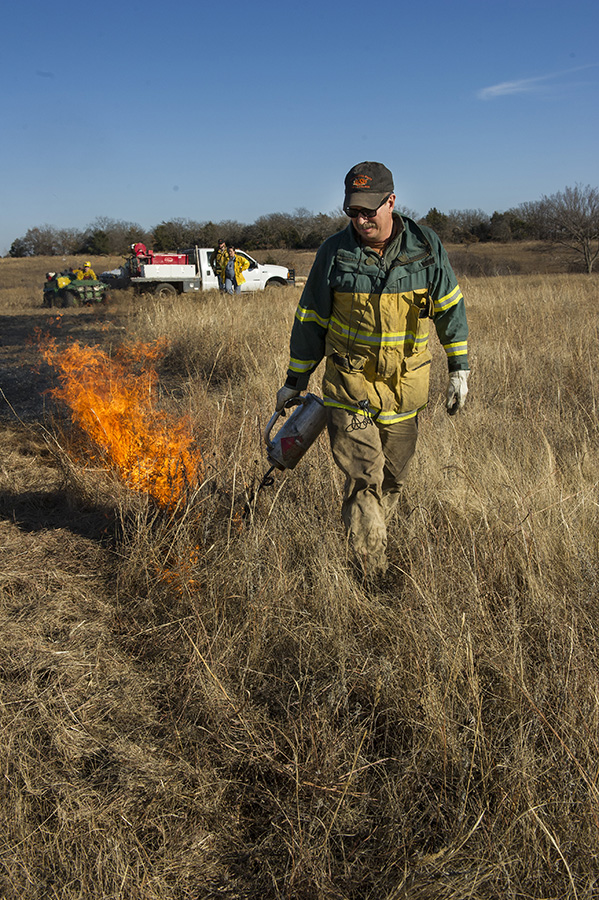Prescribed Burn Equipment
Introduction
Having proper or adequate equipment on a prescribed fire is just as important as writing burn plans, firebreak preparations or having the correct weather conditions. Oftentimes, burn managers will make equipment checklists prior to the burn; ensuring all needs have been met. Equipment may range from what the crew should wear to the type of pumper unit one might have on a fire. In planning a prescribed burn, one of the most important steps is considering what equipment is needed to properly protect the burn crew and contain the fire. There is no standard equipment list for conducting a burn. However, it is important to consider all equipment that could be used to make the prescribed burn safer and easier. When determining what equipment is needed it is best to go by the adage of “better to have it and not need it, than need it and not have it.” Always remember no two burns are the same and each burn can require different pieces of equipment. All equipment should be well-maintained and kept in good working condition. Immediately prior to use, all equipment should be tested to verify that it is working correctly and to make any needed adjustments. All crew members should be familiar with the operation of all equipment that will be used. The purpose of this Fact Sheet is to review the equipment commonly used for prescribed fires and explain how each item might be used during a prescribed fire.
Clothing
Proper clothing is an important safety aspect of conducting prescribed fires. Clothing or personal protective equipment (PPE) selected can affect mobility, safety and the amount of radiant heat absorbed or released while burning. Clothing for prescribed burning consists of headwear, protective eyewear, shirts, pants, gloves and footwear. Personnel working for state or federal agencies have guidelines regarding fire clothes and are required to wear full PPE during a burn. While private land managers and owners have the option to wear whatever they choose, all personnel conducting burns need to wear clothing that is safe and proper. Whether you are a burn boss or just assisting a neighbor, it is important to understand what clothing is safe to wear and what items should not be worn on the fireline.
Headgear
Headgear is worn to protect the wearer from  falling embers and accidental impacts to the head. Helmets offer the best protection
to the wearer during prescribed burns and should be worn at all times while working
on the fire line.
falling embers and accidental impacts to the head. Helmets offer the best protection
to the wearer during prescribed burns and should be worn at all times while working
on the fire line.
Helmets also allow the wearer to attach other safety items to them, such as face shields
or shrouds, providing further protection to the neck, face and ears. At a  minimum, personnel conducting prescribed burns should wear some type of cap or hat.
This will help protect them from falling embers, while also holding their hair out
of the way. Just make sure that whatever is worn on the head is non-flammable, will
not melt and is otherwise fire and heat resistant.
minimum, personnel conducting prescribed burns should wear some type of cap or hat.
This will help protect them from falling embers, while also holding their hair out
of the way. Just make sure that whatever is worn on the head is non-flammable, will
not melt and is otherwise fire and heat resistant.
 Safety glasses, goggles, and other eye protection are important to wear when conducting
a burn. Eye protection can reduce smoke impacts to the eyes by keeping debris and
embers out of your eyes. Make sure that whichever type of eye protection you choose,
it fits securely, provides proper protection. (Photos courtesy: K. Davis top, M. Waters
middle, J. Weir bottom)
Safety glasses, goggles, and other eye protection are important to wear when conducting
a burn. Eye protection can reduce smoke impacts to the eyes by keeping debris and
embers out of your eyes. Make sure that whichever type of eye protection you choose,
it fits securely, provides proper protection. (Photos courtesy: K. Davis top, M. Waters
middle, J. Weir bottom)
Eye Protection
Safety glasses, goggles and other types of eye  protection are important to wear when conducting a burn. Eye protection can reduce
smoke impacts to the eyes by blocking floating debris and embers. Whichever type of
eye protection is chosen, make sure it fits securely, provides adequate protection
and is heat resistant and non-flammable. From experience, safety glasses offer the
best eye protection to the wearer. This is because people will wear them the entire
time while burning. Safety glasses are inexpensive, relatively more comfortable and
provide smoke protection similar to goggles.
protection are important to wear when conducting a burn. Eye protection can reduce
smoke impacts to the eyes by blocking floating debris and embers. Whichever type of
eye protection is chosen, make sure it fits securely, provides adequate protection
and is heat resistant and non-flammable. From experience, safety glasses offer the
best eye protection to the wearer. This is because people will wear them the entire
time while burning. Safety glasses are inexpensive, relatively more comfortable and
provide smoke protection similar to goggles.
Safety glasses, goggles, and other eye protection 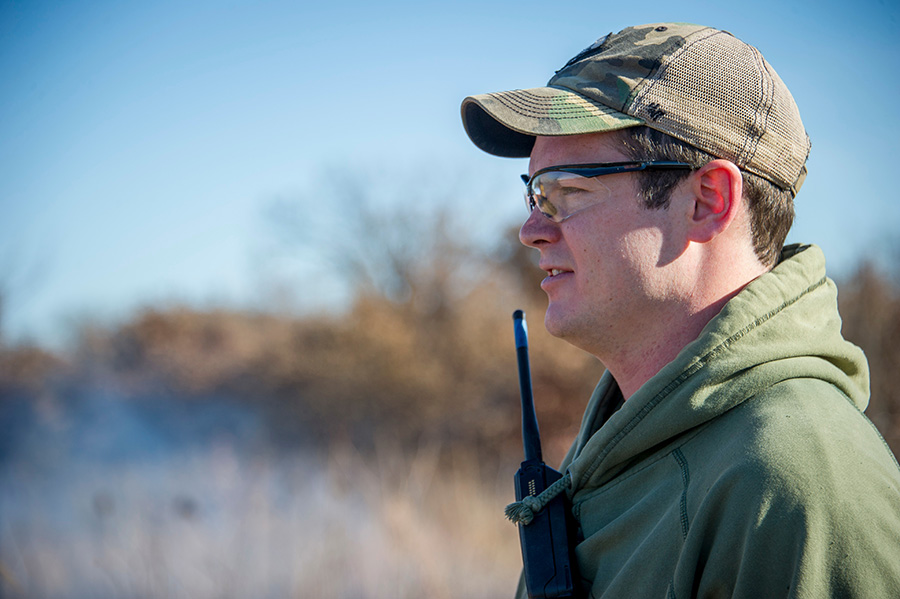 are important to wear when conducting a burn. Eye protection can reduce smoke impacts
to the eyes by keeping debris and embers out of your eyes. Make sure that whichever
type of eye protection you choose, it fits securely, provides proper protection. (Photos
courtesy: M. Waters top, T. Johnson bottom)
are important to wear when conducting a burn. Eye protection can reduce smoke impacts
to the eyes by keeping debris and embers out of your eyes. Make sure that whichever
type of eye protection you choose, it fits securely, provides proper protection. (Photos
courtesy: M. Waters top, T. Johnson bottom)
Shirts
Shirts should be long sleeve and free of rips, tears or holes. Shirts also need to be made of fire resistant (FR) or non-flammable material such as: 100 percent cotton, 100 percent wool, Nomex®, Indura® FR cotton, Tescasafe® or other FR-rated cloth. The most important thing to remember when working near fires to not wear synthetic materials such as nylon. Synthetic material can melt or ignite, causing severe injury to the wearer. Shirt sleeves need to remain down to protect the wearer from burning embers, hot parts of a drip torch or other equipment, radiant heat, briars, thorns and other items that could cause injury.
Pants
Pants should also be made of FR or non-flammable material such as: 100 percent cotton, 100 percent wool, Nomex®, Indura® FR cotton, Tescasafe® or other FR-rated cloth. As with shirts, do not wear pants made of synthetic material. Furthermore, they also need to be free of rips, tears or holes; reducing the chance of radiant heat burns and the ignition of frayed edges.
Jumpsuits
One-piece suits also work well for conducting prescribed burns. They can be worn over other clothing and provide plenty of protection. Make sure the jumpsuits have no tears, holes or rips and are made of the same fire-resistant material as shirts and pants.
Gloves
Gloves should be all leather, free of holes and worn at all times while  conducting the burn. Use gloves that are chrome tanned, which is what most work gloves
are, and not oil tanned. Oil-tanned gloves will shrink if exposed to extreme heat,
causing burns. Avoid gloves made all or partially of synthetic material or canvas.
These type of gloves do not provide adequate protection from radiant heat and synthetic
material can ignite or melt; causing injury to the wearer.
conducting the burn. Use gloves that are chrome tanned, which is what most work gloves
are, and not oil tanned. Oil-tanned gloves will shrink if exposed to extreme heat,
causing burns. Avoid gloves made all or partially of synthetic material or canvas.
These type of gloves do not provide adequate protection from radiant heat and synthetic
material can ignite or melt; causing injury to the wearer.
 Clothing should be free of rips, tears, or holes and made of fire resistant (FR) or non-flammable material.
The most important thing to remember when working near fires is to not wear synthetic
materials such as nylon. Synthetic material can melt or ignite, causing severe injury
to the wearer. (Photos courtesy: M. Waters top, K. Davis bottom)
Clothing should be free of rips, tears, or holes and made of fire resistant (FR) or non-flammable material.
The most important thing to remember when working near fires is to not wear synthetic
materials such as nylon. Synthetic material can melt or ignite, causing severe injury
to the wearer. (Photos courtesy: M. Waters top, K. Davis bottom)
Footwear
Comfortable, yet safe footwear is very important. Most federal agency personnel are required to wear 8- to 10-inch tall all-leather, lace-up boots with Vibram®-type soles. This type of boot provides the best protection for feet and ankles when working on uneven ground. The best recommendation is to work in what is comfortable. Consider the distance you may have to walk and the unevenness of the terrain, as well as puncture resistance if working near rock outcrops or thorny plants. Just like shirts and pants, make sure your footwear is made of non-flammable, heat resistant materials. Therefore, avoid rubber boots, pac-type boots or other boots with rubber or synthetic components.
Face protectors
Face shields, face protectors, hoods and shrouds are used to keep heat off of your ears, face and neck. They are most important when working near the fire or in areas of high radiant heat. There are several different types of face protectors available. Clear face shields made of heat-resistant material are normally attached to a helmet and can be pulled down over the face when needed, reflecting heat off of the wearer. Cloth (ear, neck and face protector) shrouds are typically made of Nomex® and also attach to a helmet. When needed, they can be pulled into place and fastened. Hoods pull over the head and cover ears, hair, neck and face. Just remember to be sure whatever you wear around your face for protection is made of 100 percent cotton, 100 percent wool, Nomex®, Indura® FR cotton or other FR-rated material.
Hair
If you have long hair, be sure to tie it back or braid it to keep it out of the fire and out of your face, which would block your vision. If it is long enough, tuck it inside the back of your shirt. Also, be careful with facial hair (beards and mustaches), especially when extinguishing drip torches.
Weather Instruments
It is extremely important to know what the on-site weather conditions are before conducting the burn. Prior to starting a prescribed burn, the on-site weather conditions should be taken, as weather forecasts projected from only a few miles away can be different from actual conditions on the site This can be accomplished with a digital hand-held weather device. Several companies offer different models of hand-held weather monitoring devices. When deciding on which one to choose, be sure that your device can determine wind speed, temperature and relative humidity at the very least.
When using a digital weather device, be sure to give the instrument time to equilibrate to the outside conditions. It cannot be taken off the dash of a vehicle or out of your pocket and immediately be expected to give correct weather readings. Be sure to take your observations away from any active fire or radiant heat that may distort the readings. When taking wind speed, be sure to point the device into the wind and avoid objects that may disrupt airflow, causing inaccurate readings. Be sure to record the on-site weather observations as they are measured for future reference.
Once the burn is underway, weather conditions should also be monitored periodically throughout the burn. This allows fire managers to determine if the fire is within prescription, if current weather conditions are similar to what was forecasted and what the actual conditions are at the burn site. These three components help fire managers to understand how a fire is burning and to more accurately predict how it will burn.

It is extremely important to know what the onsite weather conditions are prior to conducting the burn. This can be accomplished with a digital hand-held weather device. (Photo courtesy T. Johnson)
Radios
Radios allow for communication between the fire boss and burn crew; ensuring  the burn will be conducted safely, effectively and correctly. There are two types
of radios: mobile radios, normally mounted in a vehicle and hand-held radios that
are carried by an individual. Before conducting a burn, make sure everyone understands
how to operate the radios and that they are all on the same frequency.
the burn will be conducted safely, effectively and correctly. There are two types
of radios: mobile radios, normally mounted in a vehicle and hand-held radios that
are carried by an individual. Before conducting a burn, make sure everyone understands
how to operate the radios and that they are all on the same frequency.
When speaking into the radio, make sure the operator holds it the proper distance from their mouth when speaking. If it is too far away, the message will be difficult to hear and understand. When talking on the radio it is best to use clear text communication or normal conversation. This ensures that everyone easily understands all commands and messages. In the event of an emergency situation, do not shout; remain calm. Hold down the button the entire time you are speaking, and then release the talk button when finished. This helps to relay critical information about the situation clearly and effectively.
When purchasing radios, select ones that have sufficient range. Vegetation and terrain
can block transmission between radios in certain situations reducing  their effective range. When conducting burns across large tracts of land, it may be
necessary to have someone in a location that can hear both parties. This allows messages
to be relayed across the burn unit between the two parties by a third person. Lack
of communication between burn crew members can make prescribed burns difficult and
unsafe. Check compatibility between radios prior the burn, especially if new radios
have been purchased or borrowed. If there are not enough radios for each crew member
to have one, the fire boss and crew leaders should have priority. Take any additional
radios that remain and spread them out along the fire line. Doing this allows you
contact all around the burn unit. Be sure the radios are not bunched up in just a
few locations, but rather spread from the lead torch to last person monitoring the
burn.
their effective range. When conducting burns across large tracts of land, it may be
necessary to have someone in a location that can hear both parties. This allows messages
to be relayed across the burn unit between the two parties by a third person. Lack
of communication between burn crew members can make prescribed burns difficult and
unsafe. Check compatibility between radios prior the burn, especially if new radios
have been purchased or borrowed. If there are not enough radios for each crew member
to have one, the fire boss and crew leaders should have priority. Take any additional
radios that remain and spread them out along the fire line. Doing this allows you
contact all around the burn unit. Be sure the radios are not bunched up in just a
few locations, but rather spread from the lead torch to last person monitoring the
burn.
Radios allow for communication between the fireboss 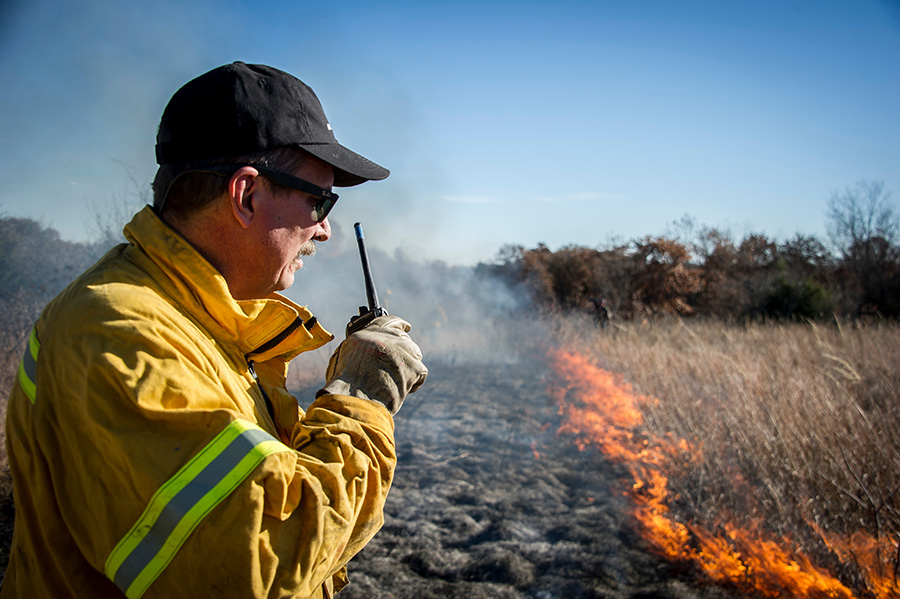 and burn crew; ensuring the burn will be conducted safely, effectively, and correctly.
If everyone on the fire crew is not able to have a radio, the fire boss should have
one, along with crew leaders. Spread the remaining radios out along the fireline to
help maintain contact around the burn unit. (Photos courtesy: C. Stanley top, K. Davis
middle, T. Johnson bottom)
and burn crew; ensuring the burn will be conducted safely, effectively, and correctly.
If everyone on the fire crew is not able to have a radio, the fire boss should have
one, along with crew leaders. Spread the remaining radios out along the fireline to
help maintain contact around the burn unit. (Photos courtesy: C. Stanley top, K. Davis
middle, T. Johnson bottom)
Hand Tools
Hand tools have multiple uses on prescribed burns. They can be used to

construct firebreaks, suppress spot fires, mop-up after the fire and even set fire. All hand tools require physical exertion for operation and need to be handled safely. Most hand tools used for prescribed burns have a sharp edge or point that should be used appropriately. When carrying hand tools along the fire line, they should be carried at the balance point on the handle (typically located just behind the head). When carrying them across slopes, make sure the tool is on the downhill side. Maintain a safe distance between other crew members when using and walking with hand tools. Do not stand with the tool resting across your shoulder; this can be dangerous to others if you happen to turn around quickly. If you have a sheath for the tool, use it to cover any sharp edges not only for safety, but also to maintain the tool’s effectiveness.



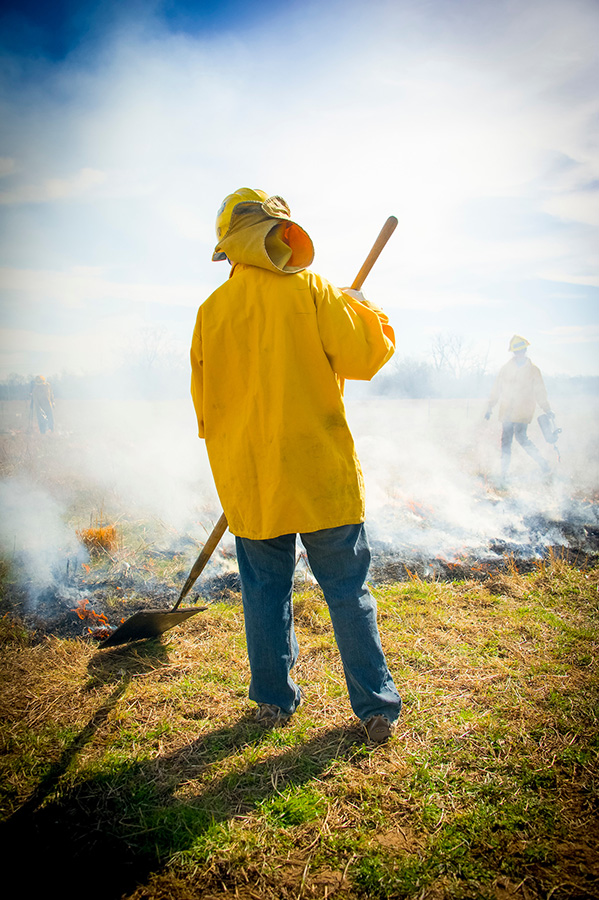
Hand tools can be used to construct firebreaks,
suppress spot fires, mop-up after the fire, and even set fire.
All hand tools require physical exertion for operation and need to be handled
safely. Maintain a safe distance between other personnel when using and walking with hand tools. (Photos courtesy: S. Coffey first and second, T. Johnson third, J. Weir fourth and fifth right)
Fire Rake/McLeod
These tools have multiple uses on the fire line. Prior to the ignition of the fire, they can be used to pull mulch piles from a mowed line, clear out or create firebreaks, move debris piles and cut through woody shrubs. Throughout the burn, rakes can be used to mop-up burning and smoldering debris along the fire line. They can also be an effective tool in extinguishing a spot fire or escape. Fire rakes work best in light fuels with low fire intensity and when used behind a water source, suppressing any fire that may still be burning or rekindling. In situations where unburned fuels are left near the fireline, a rake can be used to ignite fire by collecting flaming fuel in the teeth and then dragging it through the unburned areas.
Leaf Rake
Leaf rakes work very well in certain situations on prescribed fires. Leaf rakes can be used to clear a firebreak of loose fuels such as leaf litter, or mop-up and suppress spot fires in light fuels. The flexible tines make leaf rakes extremely useful in rocky terrain because they can easily clean out burning debris between rocks, unlike a standard fire rake. Be sure to choose a leaf rake with heavy metal tines, as plastic tines can melt and catch fire.
Fire Broom
A fire broom has treated bristles that are coarse and fire resistant. They work well for mop-up by sweeping light debris back into the black. Fire brooms can also be utilized to suppress low-intensity fires in light fuels. When using the broom for suppression behind a water source, it is best accomplished by sweeping the flames back into the burned area.
Swatter/Flapper
This tool is mainly used for suppression in short grass and leaf litter. Swatters are used by grasping the handle with both hands, then moving the rubber portion in a back and forth motion over the flames to smother them. Flames can be extinguished in light fuels by swatting them, but be careful; this technique can cause the fire to spread if slapped too forcefully. Do not leave the swatter over the flames for a very long period of time as the heat will cause the rubber portion to melt or catch fire.
Shovel
Shovels can be used for firebreak construction, fire suppression and mop-up. During mop-up, these tools can be used to move debris, cover immovable smoldering objects with soil or dig trenches down slope of logs that may to prevent them from rolling. Shovels work best in coarse textured, loose soils and in areas where the vegetation is not extremely thick. Shovels can also be used to help dig out stuck vehicles.
Backpack Pump
Backpack pumps are available in several different configurations for fire use. Each backpack pump holds five-gallons of water making them weigh more than 45 pounds. There are two types of soft bladder backpack pumps. One is canvas with a replaceable rubber bladder, while the other is made of vinyl. Hard backpacks also come in two types: poly plastic or metal. All backpack pumps have their pros and cons. Bladder backpack types can be more comfortable to wear due to the softness of the bladder and its ability to conform to the wearers back. However, with time, these soft backpack pumps are more susceptible to wear and tear requiring the bladders to be replaced from time to time. In contrast, the metal or poly plastic backpack pumps can last a long time, but are bulky and less comfortable to wear.
To operate a backpack pump, first fill it up with water. Grasp the wand in both hands, with your right hand holding the wand toward the rear and the left hand holding the bell shaped nozzle end (if left-handed, hold opposite). Keeping your right hand and arm steady, pull out with your left hand on the nozzle end and then push it back in to
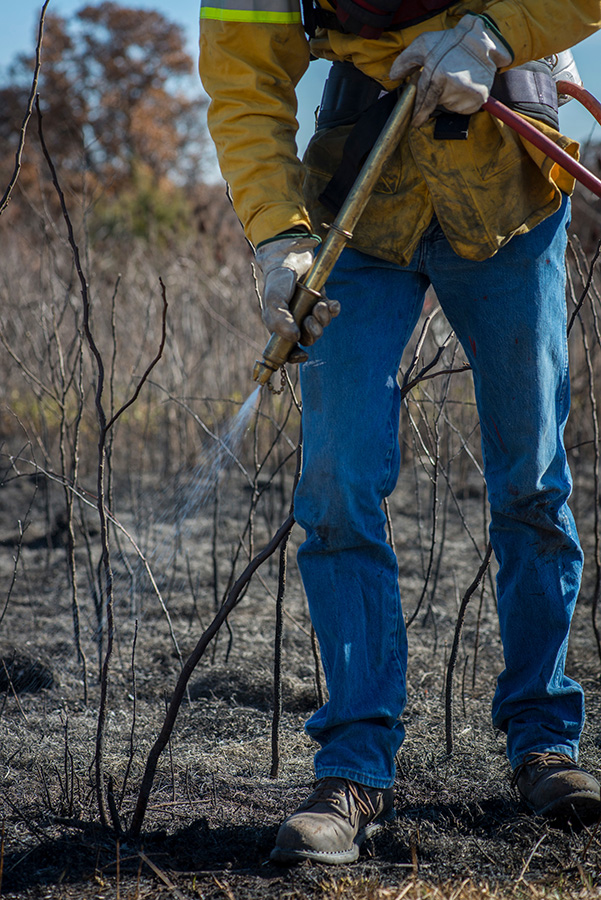
discharge the water. Repeat this procedure as needed. The water should be aimed at the base of the flame to achieve maximum effectiveness. There are two spray nozzles on most backpack pumps. One has a single hole for a straight stream; this can be used for penetrating into soil or shooting water a further distance. The other has two holes that produce a fan spray; this is used to rapidly cool down larger areas. The fan spray should be used most of the time because it is very effective for wetting down areas
and fire suppression. If you need to change the nozzle type, simply remove the one you are using, flip it over to the other nozzle and screw it back down. Occasionally, the nozzle may become clogged from debris in the tank or water. If this happens, unscrew the nozzle and tap the bottom side against the wand to dislodge the debris. Before putting the nozzle back on, look through the holes to see if the debris was removed. If the debris was not removed, you may have to take a stem of grass or small twig and push the debris out. Care should be taken so the twig does not break off in the nozzle.
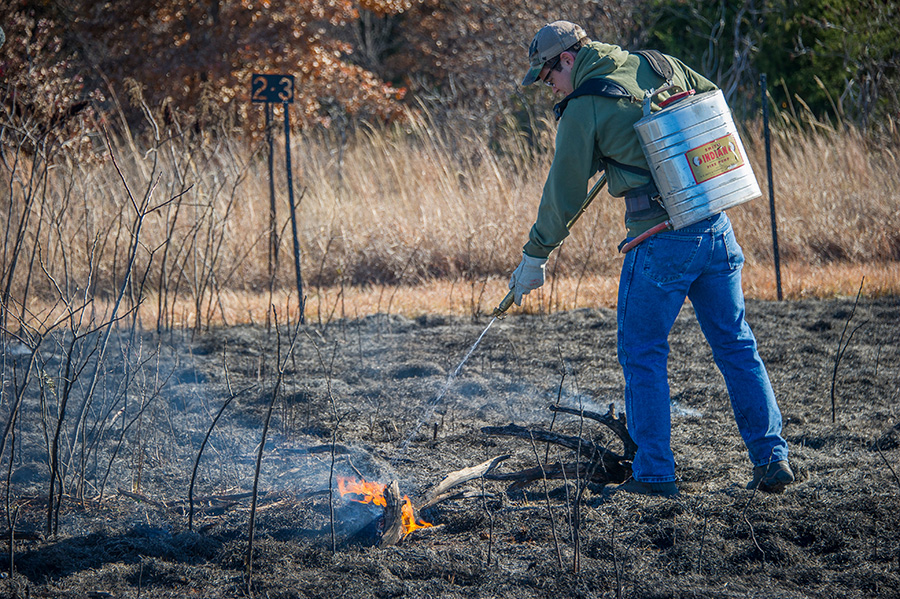
Backpack pumps can be used to lay down a wet line in areas a pumper unit may not be able to reach and to follow-up when burning from a mowed line/wet line. Backpack pumps are also very effective for suppression of small spot fires. They should be placed along the fire line where they may be needed to suppress any creeping or spot fires. (Photos courtesy: T. Johnson)
If you run out of water in the backpack pump, go to the nearest pumper for refilling. If in an emergency situation, backpack pumps can be filled from a water tank, pond or creek. When filling from emergency sources such as a creek or pond, be very careful to not allow any debris, such as moss, dirt and leaves into the backpack pump. If you let debris into your pump, it will clog rendering your backpack pump useless when its needed most.
Backpack pumps are very versatile pieces of equipment. They can be used to lay down a wet line in areas a pumper unit cannot reach and to follow-up flankfire/headfires when burning from a mowed line/wet line. Backpack pumps are very effective for suppression of small spot fires and should be strategically placed along the fire line where they are most needed. A person with a backpack pump can respond more quickly than a pumper can and will typically reach the spot fire when it is still small enough to be easily contained. Backpack pumps can also access areas where vehicles cannot travel. If a spot fire occurs, the backpack pump can then be used to suppress the fire, being the main firefighting tool. They are also effective as a follow-up tool to knock down flare-ups behind the pumper.
Leaf Blower
Leaf blowers can be used for many different tasks on prescribed burns. One of the most common uses for a leaf blower is to clear a line down to bare mineral soil; thus creating a firebreak. In forested areas, the combined use of leaf blowers and rakes can quickly create adequate firebreaks. When in light fuels or working along the backfire/ flankfire, leaf blowers can be used to suppress fire. If using leaf blowers to suppress fire, make sure to blow the flames and embers into the black, being careful not to spread more fire.
Leaf blowers are excellent for mop-up. After the fire has moved away, a leaf blower can be used near the edge of the burned area to blow smoldering debris back into the black. Leaf blowers are extremely effective mopping up mulch piles, cow chips and small brush piles. This can be accomplished by blowing air into the burning debris; increasing the amount of oxygen the fire takes in. This accelerates the ignition and combustion process to completion, reducing the potential risk of fire escape from smoldering fuels later when the crew has already left the site.
When operating or working near leaf blowers, be sure to wear hearing protection and protective eyewear. Personnel operating leaf blowers normally cannot hear messages on the radio and therefore should stop and check in periodically determining the needs or status of the fire. Make sure everyone knows how to operate the leaf blower, as various brands have different controls. Lastly, inform everyone of the type of fuel mixture used to operate a leaf blower and where it is located prior to conducting the burn.
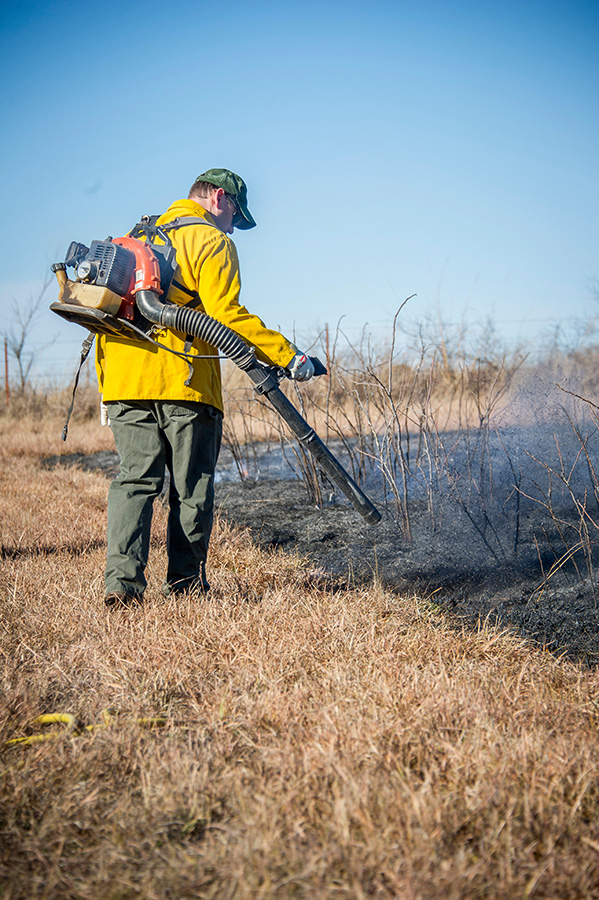
Leaf blowers can be used for many different tasks on prescribed burns. One of the most common uses for a leaf blower is to clear a line down to bare mineral soil; thus creating a firebreak. When in light fuels or working along the backfire/ flankfire, leaf blowers can be used to suppress fire. Leaf blowers are extremely effective on mopping up mulch piles, cow chips and small brush piles. (Photo courtesy T. Johnson)
Chainsaws
If the burn area has any trees, downed branches, dead snags or brush piles, consider having a chainsaw available. Chainsaws can be used prior to the burn to remove problem trees or logs and to clear firebreaks. It can also be important to have during or right after the burn to cut down or cut up burning trees and logs, reducing spot fire potential. When using a chainsaw, safety should be the top priority. Remember, most of the time the tree you are working on is either dead and/or on fire. Overhead limbs will be extremely brittle and may fall while you are working under them. As a point of safety, post a lookout to watch for falling debris. Chainsaw operators should wear full protective gear including: FR clothing, helmet, eye protection, hearing protection, gloves and protective chaps. Care should be taken when operating the chainsaw near hot spots on the tree due to the air movement created by the saw. This can cause flames to flare-up injuring the operator or damaging the saw. Be sure to have two-cycle engine fuel in marked containers for refueling and that the crew knows their location.
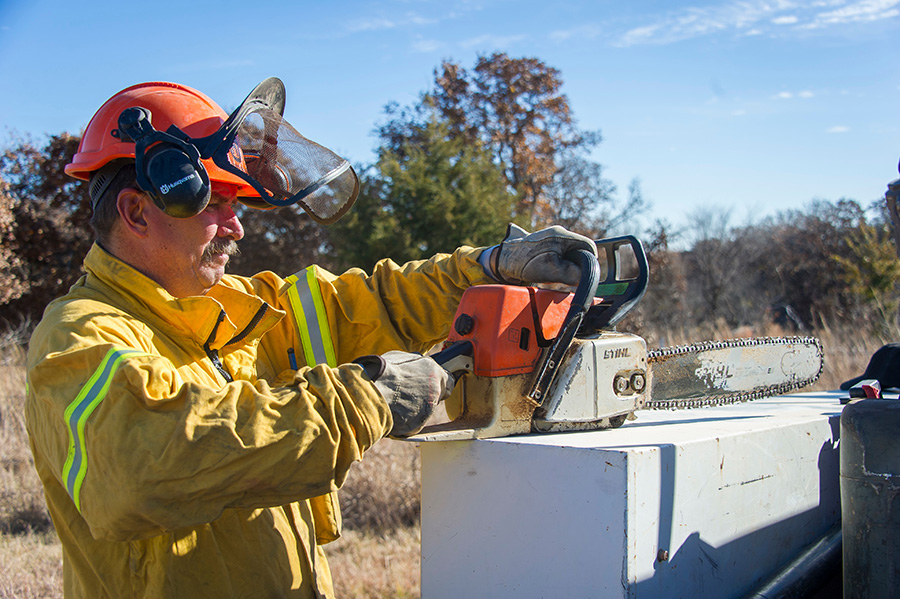
When using a chainsaw, safety should be your top priority. Chainsaw operators should wear full protective gear. Care should be taken when operating the chainsaw near hot spots on the tree due to the air movement created by the saw, which can cause flames to flare-up injuring the operator or damaging the saw. (Photo courtesy T. Johnson)
Drip Torch
When the time comes to light the prescribed burn, there are several different ignition devices available. The most widely used ignition device is a drip torch. To set up and use a drip torch, first place it securely on the ground. Unscrew and remove the lock ring; then remove the flow plug placing it in the holder adjacent to it. Once secure, pull the spout assembly out of the torch body and carefully let the fuel drain from the spout back into the can. Place the spout in the upright position on the can, with the spout loop opposite the handle. Then, set the lock ring back over the spout and screw it down securely to prevent any leaks. Lastly, adjust the air vent located right above the handle. This allows torch fuel to flow through the spout onto the wick. When adjusted properly, fuel will flow continuously onto the wick, keeping it lit and providing a steady drip of ignited fuel to create a continuous burn line. To operate a drip torch, tip it towards the ground and allow the fuel to run out. To stop ignition, lift it up. To store the torch, reverse the steps above, making sure the wick and spout have cooled before placing them inside the torch body.
To ignite the drip torch, tip it down and carefully let fuel pour onto the ground. Light the fuel with a match or lighter and then place the wick in the flames. This should be done in an area of bare soil or light fuels within the burn unit. If the fire has already been started, stick the wick into the flames to light the torch. For personal safety, be sure to light the torch in a less intense areas of the fire. To extinguish the drip torch, hold it upright and forcefully blow out the flaming wick. If that doesn’t work, cover the flaming wick with the gloved hand or use a combination of both techniques. If you have facial hair, be careful when blowing out the wick out.
Drip torches use a mixture of diesel and gasoline. The ratio of the mixture will vary with air temperature and personal preference. A mixture of 50:50 diesel to gasoline works very well for temperatures ranging from 35 F to 75 F. When temperatures are higher than this, a mixture of 60:40 or 70:30 diesel to gasoline is recommended to reduce the volatility of the gasoline and to help the torch operate properly. Waste oil can also be used in place of diesel fuel in torches. Use the waste oil at the same ratio as diesel in the mixture. When re-fueling a drip torch, keep it inside the burn unit and move a safe distance away from any actively burning areas. Watch for any firebrands that could blow into the re-fueling area.
When using a drip torch, safety should be foremost in the operator’s mind. Personnel should be wearing gloves, long sleeved shirts and pants made of FR material. People with long hair should tie it back and put it inside their shirts so it does not blow around and catch fire. A lit drip torch should never be allowed outside of the burn unit. If you stop lighting for any period of time, extinguish the torch to reduce wick damage allowing the torch to operate properly. The torch bearer lighting fire should be aware of people around them at all times and be sure not to trap anyone with fire or to become trapped themselves.
The most widely used ignition device is a drip torch. Drip torches use a mixture of diesel and gasoline. A mixture of 50:50 diesel to gasoline works very well for temperatures ranging from 35 F to 75 F. When temperatures are higher than this, a mixture of 60:40 or 70:30 diesel to gasoline is recommended to reduce the volatility of the gasoline and to help the torch operate properly. (Photos courtesy: J. Weir top and second, J. Bradley third, T. Johnson fourth)
Burn Signs
Burn signs are important when burning in areas that are highly populated or along a high-traffic road. Caution signs should be used to slow traffic and make the public aware of what is taking place. Signs may deter people from calling the local fire department, which can keep emergency response phone lines clear in case an actual emergency were to arise. Make sure the signs are easy to read, set-up properly so they don’t blow over, are highly visible and placed in locations where they can be easily viewed by motorists.

Caution signs should be used to slow traffic and make the public aware of what is taking place. Signs may deter people from calling the local fire department, which can keep emergency response phone lines clear in case an actual emergency were to arise. (Photo courtesy T. Johnson)
Pumper Units
The most important and sometimes most costly piece of equipment needed on a prescribed burn is a slip-on pumper unit. These units can be shop-built or purchased from dealers. Several things should be considered when building or purchasing a pumper unit. The first is tank size. Choose the proper tank size for the vehicle you are planning to put it in. Do not overload the vehicle; know what the gross vehicle weight rating (GVWR) for each particular vehicle is before deciding on a tank to purchase. Overloading can be a serious safety hazard and can damage the vehicle or cause it to get stuck. When calculating gross weight, remember to account for the weight of the pump, engine, frame, fuel, water tank and other tools that will be on the truck; not just the water. Along with the weight, the height of the tank is equally important. Tall tanks raise the center of gravity, which can cause an increase in the probability of a rollover accident. Depending on the size of the vehicle and tank, it is best to consider a tank that is baffled. Baffles will reduce water movement inside the tank, keeping the vehicle more stable as the water levels decrease.
The next item to consider is what type of pump best fits your needs. There are numerous types of pumps with each producing different amounts of pressure (psi) and flow (gallons per minute GPM), along with having a wide range of cost. There are two main types of pumps – high pressure-low volume and low pressure-high volume. A high pressure-low volume pump usually produces from 300 to 550 psi of pressure and flows 8 to 16 GPM. These high-pressure units are usually a piston or diaphragm-type pump. The low pressure-high volume pump will produce from 25 to 250 psi, flow from 10 to 150 GPM, and will usually be a roller or centrifugal type pump.
The type of pump used will depend upon requirements out in the field. The main thing to remember is that on any prescribed burn, water can be the limiting factor. The most successful prescribed fires do not use any water at all. However, if water is needed, it should to be delivered effectively and consistently. High pressure-low volume pumps work best on prescribed burns. Again, high-pressure/low volume pumps not only help to conserve water, but also aid with suppression of the fire as they produce a forceful stream of water. If you have a high pressure-low volume pump that produces 10 GPM with a tank that holds 200 gallons, you have the ability to spray water for 20 minutes. At the same time, a high volume-low pressure pump that produces 50 GPM having the same size tank will give you only 4 minutes of water before needing to refill.
After figuring out the specifications of your vehicle and pumper unit, the next thing to consider is how to get the water from the pumper unit on to the fire. The type, size and amount of hose needed for a pumper unit is an important decision to be made. Hoses come in two types, hard line or soft line. Soft line hoses are collapsible, light and easy to maneuver. One downside is that the entire length of hose must be stretched out before pressuring-up. Furthermore, soft hoses may not be rolled up while they have pressure on them and they must be dried out and cleaned before storage. This helps prevent mildew damage. Soft hoses are not very practical for most prescribed fire applications.
Hard line hoses have a hard outer shell. This allows them to withstand higher internal pressures and external damage. While pressured up, hard line hoses can be unrolled and rolled up. Another plus to hard line hoses is that you can pull out the amount of hose needed for a particular use rather than the entire hose. One drawback is that larger hose diameters become heavy; making it difficult to pull long lengths of hose without help from another person. Even so, for most prescribed burning situations, hard line is the best type of hose to use. Hard line hose with ½-, ¾- and 1-inch diameters are the best sizes to use depending upon your pump’s capability.
If burning in areas where the terrain limits vehicular travel, having a hard line hose up to 300 feet long can allow you to reach areas where your vehicle cannot go. It is also useful to have a short hose or whipline plumbed into the unit. These whiplines are normally about 15 to 25 feet long and are used right around the vehicle. This keeps you from having to unwind or pull hose from the reel while spraying near the vehicle. Having a whipline also allows you to pull out the longer hose for work away from the truck, while still having the ability to work right next to the vehicle. Make sure the pump has the GPM to handle two nozzles working at once before installing one.
Nozzles are another important piece of equipment and can widely range in GPM output and cost. A nozzle that has a variable stream adjustment works the best. Most adjustable nozzles will go from a straight stream to a cone or fog pattern. The cone or fog pattern works best for spraying wetlines, spot fire suppression and cooling down areas. The straight stream works well when trying to reach long distances, knock down hot areas and penetrate into the soil, which helps cool down areas during mop-up. Be sure to choose a nozzle that will work with the GPM of the pump. It is extremely disappointing to see the trickling flow coming out of the nozzle if you have a 30 to 50 GPM nozzle on a pump that will only produce 10 to 20 GPM. Nozzles may also be very helpful in assisting with conserving water by further reducing the GPM of a higher rated pump.
The ability for a pumper unit to have drafting or refilling capabilities can be another important consideration. In areas where pumped water sources are limited or a long distance apart, the ability to draw water from stock tanks or ponds is important. Drafting can be accomplished by plumbing the pump to pull water or by using a separate pump. The most important thing to remember is to make sure the water being used is clean and free from debris. To keep debris from causing problems with pumps and nozzles, plumb an in-line filter on the pumper unit to strain the water before it goes into the pump.
One thing to remember is that temperatures at or below freezing, along with wind chill during transportation, can cause nozzles, hoses and pumps to freeze up. This may limit their use or cause damage rendering them ineffective. To prevent freeze damage, wait for warmer temperatures to travel or start the burn. Also, running the pumps and having the hoses and nozzles recirculate back into the tank can keep them from freezing. If equipment cannot be stored in a heated facility, make sure to drain the tank, pump, hoses and nozzles to keep them from freezing overnight. Taking these precautions can prevent costly damage to equipment or problems on the burn from cold temperatures.

The most important and sometimes most costly piece of equipment needed on a prescribed burn is a slip-on pumper unit. These units can be shop-built or purchased from dealers. Several things should be considered when building or purchasing a pumper unit. There are numerous types of pumps with each of these pumps producing different amounts of pressure (psi) and flow (gallons per minute GPM) while having a wide range in cost. From experience, high pressure-low volume pumps work best on prescribed burns. (Photos courtesy: K. Davis top and second , S. Winters third, J. Weir fourth, T. Johnson fifth)
Foam/Wetting Agents
Foam and wetting agents such as soap, increase the efficiency of water many times over. When a surfactant or class A foam is added to water, there are numerous benefits that occur. Water penetrates deeper, spreads better; water droplet size is reduced, and it can also increase the flow. Wetting agents also extend the water supply by making applications more effective. When using wetting agents such as inexpensive dish soap, add approximately one ounce per 100 gallons of water. The soap should be added to the tank after the water to minimize foaming, which can cause cavitation problems in pumps and create foam issues when filling the tank.
The recommended ratio of class A foam is between 0.1 percent and 1 percent of the tank volume. Many benefits to prescribed burning can be obtained with the addition of surfactant, or class A foam. Foam can be very useful when laying wetlines that need to last for several minutes in dry climates; protecting structures, trees or other vegetation from heat and flame; and for smothering hot spots during mop-up.
There are three basic foam mixes: wet, fluid and dry. Wet foam is watery, with large to small bubbles. Fluid foam is similar to wet shaving cream, flowing easily, with medium to small bubbles. Lastly, dry foam is very similar to shaving cream, as it is mostly air, and will cling to vertical surfaces. The consistency and amount of foam used will vary depending upon weather, need and personal preference.
Foam can be mixed into the pumper unit in several different ways. One way is batch or tank mixing. Batch mixing is just what it sounds like; it is mixing the right amount of foam concentrate into the tank. It is inexpensive and simple to do, although it does have its problems. Some foam additives can cause problems with tanks, plumbing and pumps; also priming or cavitation problems may occur if the solution is too foamy while travelling through the pump. The main drawback is that the mix ratio cannot be changed easily and the foam will cause problems when refilling the tank.
Foam proportioners regulate the amount of foam concentrate added to the water. Proportioners add foam on the intake or discharge side of the pump, by in-line or direct-injection. The amount of foam these units produce can be adjusted manually or automatically depending upon the system. One of the main things to remember when using foam proportioners is to clean and flush the lines after each use, keeping them from becoming clogged.
After the foaming agent has been added to the pumper by either method, foam will not be created unless an aspirating nozzle is used. Aspirating nozzles use energy from the water pump to create the foam. The nozzle causes air to be pulled in, thus allowing the air and the foam solution to mix in the chamber and be discharged as foam. There are several different types of aspirating nozzles that will fit many different situations, so be sure to choose the one that is best suited for your needs.
All Terrain Vehicles (ATV) and Utility Type Vehicles (UTV)
Four-wheelers, ATV’s, Side-by-sides or UTV’s all can be very important pieces of equipment on a prescribed burn. They allow crew members to travel quickly around the burn unit, transporting water to extinguish hot spots, assist with communication, patrolling firelines or hauling equipment. These vehicles can be fitted with spray tanks, but care should be exercised not to overload them when installing pump units. Be sure to read the recommended hauling weights, along with where and how to attach them for each ATV or UTV. An over-weighted vehicle is very dangerous to the driver and those around them.
Conclusion
Make sure that whatever equipment you decide on using is safe, practical, within budget and easy to operate. If you are a beginning burner, visit with other people who conduct burns in your area to see what equipment works best for them, or consider becoming involved with a local prescribed burn association (PBA). A local PBA allows you to share or borrow equipment from other members further reducing input costs, while also providing the opportunity to try certain pieces of equipment out before deciding to purchase them.
There are many different pieces of equipment available for use; remember to choose what will work best for you in your situation. For example, all hand tools have their place on prescribed burns, but some are more helpful than others. Consider your options, but more importantly, consider the benefits gained or lost by each piece of equipment you might choose for your burn program.
On every burn, safety should always be foremost. Make sure the burn crew is wearing clothing that is safe and comfortable, but does not limit their mobility. Remember, all hand tools require physical labor, so consider the operator’s abilities. Make sure the burn crew stays hydrated and that the crew members switch tasks from time to time, allowing for a break from long-term physical exertion or extreme heat. Maintain radio contact throughout the fire. Good communication makes sure the burn crew is safe and keeps the fire boss informed as to what’s taking place in different locations around a burn unit.
On-site weather is key to understanding fire behavior; check it frequently. Make sure to record relative humidity, temperature and wind speed. Considering all of these things makes for a safe and effective prescribed burn. The more planning and pre-burn preparations you make, the smoother the prescribed burn will go. The statement, “Prior proper planning prevents poor performance” holds true for prescribed burning.




John R. Weir
Research Associate, Natural Resource Ecology and Management
Oklahoma State University
R. Seth Coffey
Graduate Research Assistant, Natural Resource Ecology and Management
Oklahoma State University
Carol E. Blocksome
Research Assistant Professor, Horticulture and Natural Resources
Kansas State University
Morgan L. Russell
Extension Range Specialist, Ecosystem Science and Management
Texas A&M Agrilife Extension Service
Dirac Twidwell
Assistant Professor, Department of Agromony and Horticulture
University of Nebraska-Lincoln




